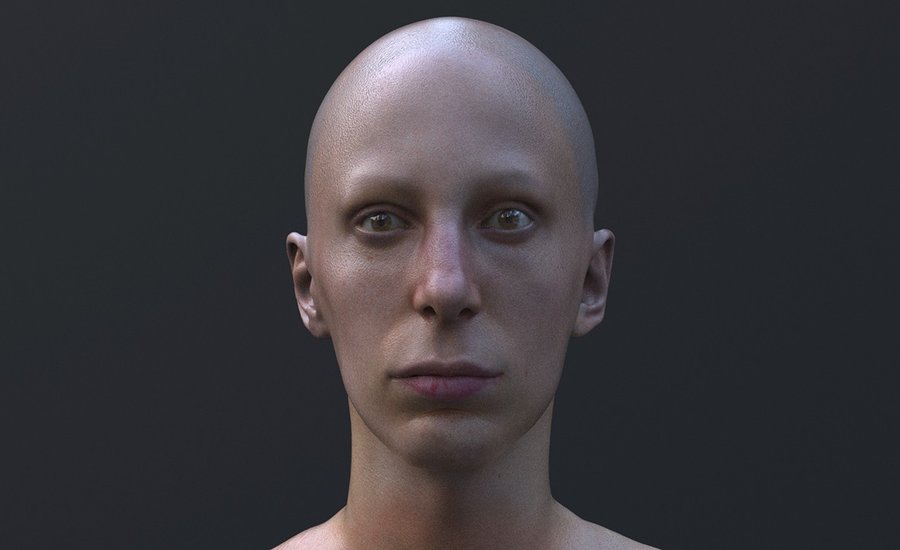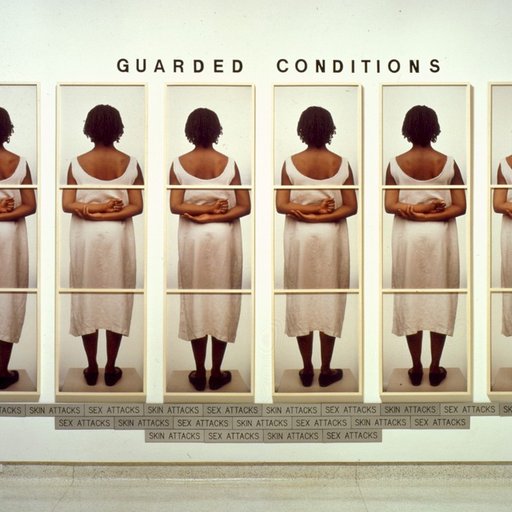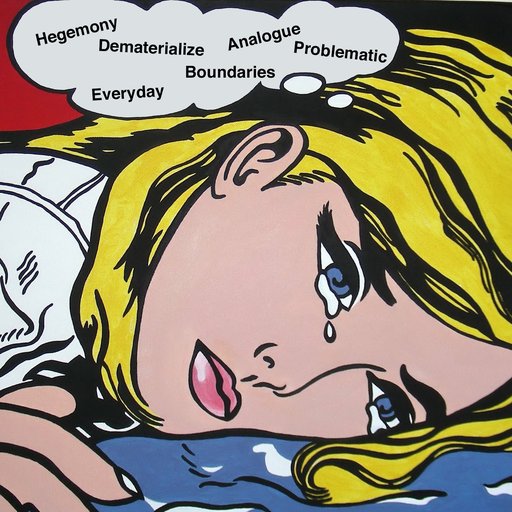For what was arguably the most controversial piece in the 2017 Whitney Biennial, Jordan Wolfson’s Real Violence required viewers to don headsets and headphones to experience a 90-virtual reality simulation. In it, Wolfson walks up to another white man (actually, it’s a convincingly realistic animatronic doll) standing on a New York City sidewalk, hits the “man” in the head with a baseball bat, and then stomps repeatedly on his bloodied head; meanwhile, through headsets, we hear Wolfson reciting a Hebrew prayer. While Wolfson’s characters were indeed virtual, their potency was in their visceral corporeality. Not only did the violence seem real, but the relationship between two bodies—two white, male, and presumably American or even New Yorker bodies—were equally as meaningful.
As virtual reality enters the vocabulary of contemporary art, we are forced to negotiate the relationship between the wet, vulnerable body of the physical world, its representation in the virtual world, and the ways in which our socially constructed notions of race and gender overlap between the two. In 1995, Karen A. Franck wrote an essay speculating on the future of virtual reality, and the potentially problematic ways in which digital communities can reflect—or amplify—the biases of the real world. Her musings from last millennium still feel relevant, even prescient, to the understanding of Wolfson’s Real Violence, and more broadly, to the experience of representing oneself online through "virtual" avatars. Excerpted from Phaidon’s Cyber Reader, “When I Enter Virtual Reality, What Body Will I Leave Behind?” prefaces issues that have influenced artists like Ivana Basic, whose SOMA project was included in another recent exhibition at the Whitney,Dreamlands: Immersive Cinema and Art, 1905–2016.
In October, Basic told Artspace’s Loney Abrams that the idea behind SOMA was to denounce “any relationship between my body and my identity,” or to “overcome that body.” A similar thought, in theory, to what Franck writes over 20 years earlier: “When I leave behind my appearance as a woman, I wish to leave behind the ways men expect women to act and the ways they often approach and react to women. Not that I wish to adopt a male identity but rather to appear as human, with no gender specified or revealed.” With SOMA, Basic auctioned lifelike models of her own body, made available to suit her customers’ whims, as a way of disintegrating any link between the idealization of the female body and her personal avatar.
Virtual reality, as a space where one’s “body” (as it were) is rendered entirely malleable by code, affords some of the same potential to work through questions of gender and identification. By separating one’s physical body from consciousness, it becomes possible for Franck to conceive of virtual reality as a space in which personification and identification are more literally distinct from flesh.
“So far,” Franck writes below, “cyberspace constructs gender as much as any other man-made place, with some additional allowances for men to play with gender but none for women to avoid it.” But when the wiggling of one’s fingers could translate to the flapping of digital wings, or just as easily, inhabiting the world as a lobster, might there one day also exist a space where we can leave all other constrictions behind?
Below, you'll find Franck's 1995 essay in its entirety, excerpted from Phaidon's Cyber Reader: Critical Writings for the Digital Era.
...
When I Enter Virtual Reality, What Body Will I Leave Behind?
In William Gibson’s novel Neuromancer, Case longs for the “bodiless exultation of cyberspace.” Again and again writers of fiction and nonfiction refer to leaving the body behind, to being free of it in virtual reality. The phrases “meat puppets” and “flesh cage” fill me with disgust and indignation, but I am nonetheless fascinated with the body and the “non-body” in cyberspace. I anticipate entering a virtual world someday soon. Will I leave a body behind? What body might I wish to leave, or keep, and why?
Virtual reality is very physical. I won’t just see changing images on a flat screen; I will have the feeling of occupying those images with my entire body. I will enter a graphic, three-dimensional, computer-constructed world that does not look real but feels real, one that may respond immediately to my movements and commands.
To enter virtual reality, I place different kinds of equipment on or around my body. A head-mounted display contains video monitors which will form stereoscopic images before my eyes. A head tracker will measure my head movements which the computer will counteract to provide the experience of a stable world. Gloves allow me to see my hands and to manipulate items; a body suit could allow my body to be represented in virtual reality, and would allow me to move it as a virtual body and to be seen by others occupying the same virtual world. Headphones give me three-dimensional sound and a microphone allows me to give voice commands.
My experience of virtual reality depends upon my physical body’s movement (or the mechanical movement of the body using a wheelchair or other apparatus). To see I must move my head. To act upon and do things in a virtual world I must bend, reach, walk, grasp, turn around and manipulate objects. Movements of the physical body, or commands, can translate to very different virtual movements—to flying, floating and moving from one place to another instantaneously. So much will be possible and so much of it physical, often requiring physical dexterity and practice—like performing surgery or playing one of the virtual musical instruments Jaron Lanier has invented.
If the virtual is so physical, what body will I leave behind? Not my physical body. Without it, I am in no world at all. It is physical bodies that give us access to any world. I will certainly need my brain so that I can be stimulated to see and feel this created world; my eyes and ears to do the seeing and hearing; my arms, hands, legs and feet, and other bones, muscles and tendons to do the moving. The organs of perception and motility are still key.
My physical body will occupy the virtual and physical worlds simultaneously; actions I take will have consequences, albeit different ones, in both worlds. As in the physical world, so in the virtual: perception will be active, depending upon actual or anticipated physical movements. If I wear transparent goggles, the virtual world will be superimposed on the physical one. If the goggles are opaque, I will be “immersed” in the virtual world and unable to see the physical one, though I may still be concerned about it.
What I will leave behind is a particular kind of “being in the world;” experiencing another kind instead. Both kinds are created by the nature of the world and our relationship to it. In virtual reality, both change. Experiences of gravity, density, mass, weight, long distance, and the cumbersomeness of matter are absent. The objects we see or create and the spaces we occupy in virtual worlds have very different visual and kinaesthetic qualities from those in the physical world, Objects/spaces can appear, disappear, occupy the same location, and change appearance instantaneously. We can move very quickly and in all different ways. There is both a fluidity and speed of movement that are more akin to dreams than waking life.
If we are “free” it is because we feel liberated from our relationship to the physical world, from the constraints and limitations that the physical world and physical matter exert upon us. So the experience of “being in the virtual world” can be exhilarating; one can do so much so quickly and so effortlessly. Here lies a sense of mastery and control unrivaled in the physical world, particularly for those who experience handicaps in that world. The constraints in virtual worlds are those that people have created in the software and, eventually, ones that any user chooses to create. They are thus made by humans. What a challenge to architects of virtual reality: not only are spaces and objects to be designed but so are all bodily relationships to them and to other bodies.
I will be the same physical body but all that I encounter and my relationships to all that I encounter, my “being in the world,” will be dramatically different. To the extent (the great extent) that my feeling of myself is constituted by my relationships to all that is not me, I will feel different, perhaps very different. Jaron Lanier says: “you have a vivid experience of your own subjectivity. You can feel your subjectivity as an angel floating above the world.” For some people, or someday, that may be a feeling of being bodiless.
What I will also leave behind, indeed must leave behind, is my appearance. Virtual bodies cannot duplicate the appearance of individuals the way films, videos or photographs do. Here is another job for architects of virtual reality—to design the bodies too. Some of the bodies that have been created so far do not take a human form at all—a lobster, for example. Virtual reality will eventually offer people a great choice of different appearances, and so different identities. Identity, as it is physically represented, will no longer be tied to the physical attributes of age, gender, race, size or even to the human species. Attributes of humans or other animate and inanimate objects will be chosen and mixed at will.
Given the frequency with which men in MUDs (Multiple User Dungeons) adopt female identities, it is possible that many men will choose virtual female bodies. Women may wish to adopt gender-neutral identities, as many already do to avoid harassment on the Internet or other networks. When we occupy virtual worlds, will it be understood that these are virtual bodies and possibly virtual identities so that “deception” is no longer an issue, as it has been on the Internet? After all, all of virtual reality is a deception. If we feel free of our physically-grounded identities, social constraints common to the physical world may recede as well as they already have in textual computer communications.
There is a body I personally do not wish to leave behind. That is the wet one, the one that needs to eat, sleep, eliminate, the one that is frail, can become diseased, and will die. It is that body with its needs, passions and mortality that some long to abandon. And it is that body that is so devalued in fiction and nonfiction about cyber-space: “… the élite stance involved a certain relaxed contempt for the flesh. The body was meat. Case fell into the prison of his own flesh.”
As in any very challenging and engrossing activity one loses track of time and bodily needs. In computer-related activities—hacking, video games, programming, perusing the Internet and now virtual reality—this involvement can be intense, overwhelming. When Case was “jacked in” he forgot the needs of the flesh: “This was it. This was what he was, who he was, his being. He forgot to eat. Molly left cartons of rice and foam trays of sushi on the corner of the long table. Sometimes he resented having to leave the deck to use the chemical toilet … He’d go straight to the deck, not bothering to dress, and jack in … He lost track of days.” But the fleshed body still requires care; so Molly brings food and at another point Maelcum, a Rastafarian no less, hooks Case to a catheter.
This caring can also include protection. Being both engrossed and immersed in a virtual world leaves one vulnerable to circumstances and persons in the physical world. To experience the sense of mastery and control in the virtual world means relinquishing what control one might have in the physical. So one must be in a safe physical location or watched over, even protected, by another person (though, of course, one is still vulnerable to this person and to others who can manipulate the software or the hardware). The sense of control, like all of virtual reality, is a powerful, physical illusion.
Leaving the flesh behind does not mean doing away with sex but rather removing its shared wetness and fleshiness. Eventually in virtual worlds sex may be simulated by stimulating the appropriate parts of the brain or it may be experienced by donning a bodysuit to engage in virtual contact with other virtual bodies. So one will feel the bodies of others but without any touching of flesh to flesh, without any contact with the fluids of another, without necessarily knowing the physically-based gender identity of the other (or others), and without revealing one’s own. Totally anonymous sex, no responsibilities, no possibility of physical, bodily harm (although there may be other kinds), and none of the physical consequences of pregnancy or sexually-transmitted disease. Already cyberspace is a very popular place for sexual contact without bodily contact; virtual reality will likely be popular in the same way but more physical.
Do I have less desire to leave this body of wet flesh and blood because I am a woman? Are others so eager to do so, or to imagine doing so, because they are men? In all likelihood, yes. For centuries men have wished to transcend the body they cannot control and direct, the one whose desires, emotions, bodily functions and bodily changes interfere with other more valued pursuits. Religion, science, and philosophy in the West have continuously, relentlessly disdained and devalued the fleshed body and its material needs and preoccupations (and associated it and them with women). To be able to escape it, at least experientially, and yet still be alive and alert, to make physical movements that have significant consequences, to do, learn, and create is truly a dream come true. And this is the ultimate design project: to imagine and create objects, spaces bodies, movement and all relationships among them without ever having to consider any of the more tedious human needs for heat, light, air, food, sleep or elimination. The architect is finally free of the “tyranny of function.”
Of course, the fleshed body is still there with all its needs, problems and vulnerabilities but it can be ignored in a new, more complete manner with its care yet again assigned to women and minorities. The desire to leave the fleshed body altogether is so great that the possibility of transferring or “downloading” human consciousness to a computer is eagerly anticipated in the computer world. In such a “post-biological world” one could thus avoid death and the time and energy required for maintaining and reproducing human bodies.
These, I believe, are masculinist dreams. The potential character and possible consequences of virtual worlds can be imagined and portrayed in feminist terms as well. Then the body I wish to leave behind is the one that I have learned to be, the one that follows the constraints and limitations society has taught me, as a woman, to adopt. These have become part and parcel of my comportment, of the way I use my body and occupy space—in a more constricted and confined manner than men. Could they be left behind? At the moment it seems unlikely. People who put on the gloves and goggles and enter virtual reality often remain aware of how they look to others watching them in the physical world and remain self-conscious of their movements. Perhaps “being a woman in the world” cannot be abandoned, even in small ways, even virtually. Nonetheless I have the wish. I’d like to try.
And when I leave behind my appearance as a woman, I wish to leave behind the ways men expect women to act and the ways they often approach and react to women. Not that I wish to adopt a male identity but rather to appear as human, with no gender specified or revealed. Even beyond the technical problems of creating a voice that is human but neither male nor female, and beyond the possibility that my actions and attitudes would “give me away,” that may be difficult. To many men using the Internet and other text-based computer communications determining the physically-based gender identities of other users is still very important; there may be pressure in virtual worlds not to remain anonymous in this sense. A gender-free realm of communication and interaction may not be a man’s dream. For him flesh may be the prison; for me it is the current social construction of gender.
So far, cyberspace constructs gender as much as any other man-made place, with some additional allowances for men to play with gender but none for women to avoid it. Given the preponderance of men creating and using computer-related inventions including cyberpunk fiction, it is not surprising that a masculinist, often sexist view predominates. If all virtual worlds will also be man-made places, they will very likely follow a similar script, with little opportunity for any of us to leave all the gendered bodies behind. Why not make some that do?
A feminist portrayal would stress the permeability and changeability of boundaries. Virtual reality dissolves the distinctions, the separations, and the connections that characterize so much of the physical world and our social constructions of it. In regard to the body alone, many different aspects can be separated and recombined conceptually and experientially. Simple dualisms of mind/body, male/female, animate/inanimate, real/imagined become far less tenable. Virtual worlds offer immense opportunities for testing and blurring boundaries in those worlds and in this one.
A significant boundary for dissolving is between self and other, all other. Virtual worlds will offer myriad opportunities to encounter and engage objects and spaces in new and different ways and to occupy other bodies, other entities, other species. The clear, hard, harsh boundaries in the physical world that define and keep me forever separate from all that is not me, that separate and distance things, bodies, and places from each other vanish. In virtual worlds the possibilities for connecting, merging, and occupying are endless. Would this not feel like a new kind of intimacy? Could this not generate, in the physical world, some of the empathy and compassion for the other that are now so sorely absent?
People already report a sense of intimacy with others they communicate with via e-mail and Internet conversations. Maybe there is yet another level of intimacy to be found with spaces, objects, or the virtual representation of other species. In Marge Piercy’s novel He She and It, Malkah, a practiced user and creator of virtual worlds who is an old woman, reflects on the power she feels as a “base-spinner.” “In the image world, I am the power of my thought, of my capacity to create. There is no sex in the Base or the Net, but there is sexuality, there is joining, there is the play of minds like the play of dolphins in the surf.”
Another significant boundary, metaphorically and technologically constructed, is between virtual reality and physical reality. Virtual reality is almost exclusively described and built as enclosed and independent of physical reality. Hence the use of the term “virtual worlds.” This construction allows virtual reality to be viewed and experienced as an escape from physical reality, further suggesting that the physical world will be neglected and devalued much as the fleshed body has been in Western culture. The masculinist dream may be as much to leave matter behind as to leave flesh behind. Both are so constraining, both create such problems. But it is also possible that participating in virtual worlds could lead to greater appreciation of flesh and matter. Another view, leading to other inventions, avoids the creation of an enclosed, separate world altogether by creating distributed cyberspaces that augment physical reality. Virtual and physical can be seen and made to be interdependent and complimentary.
Virtual reality is not a single monolithic version of reality but an endless array of possibilities to be imagined and created. If the full potential of that variety can be realized, we can create ways of being and relating to all others socially and psychologically that are true alternatives to those current in the physical world and in our present culture. Who knows, eventually that could change our ways of being and relating here, in these bodies. Then I will return to a body changed.
RELATED ARTICLES:
Artistry Vs. Novelty: Digital Art Museum Director Wolf Lieser on Virtual Reality as Art
Why "Memory/Place" Might Be the First True Virtural-Reality Art Masterpiece



























